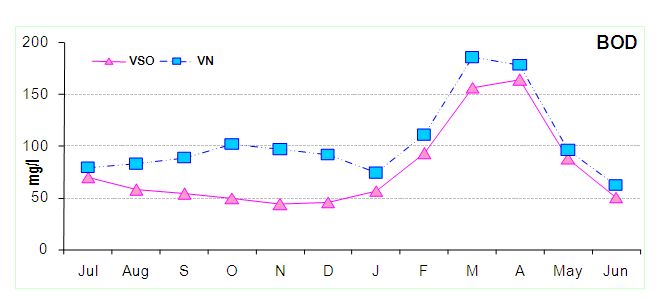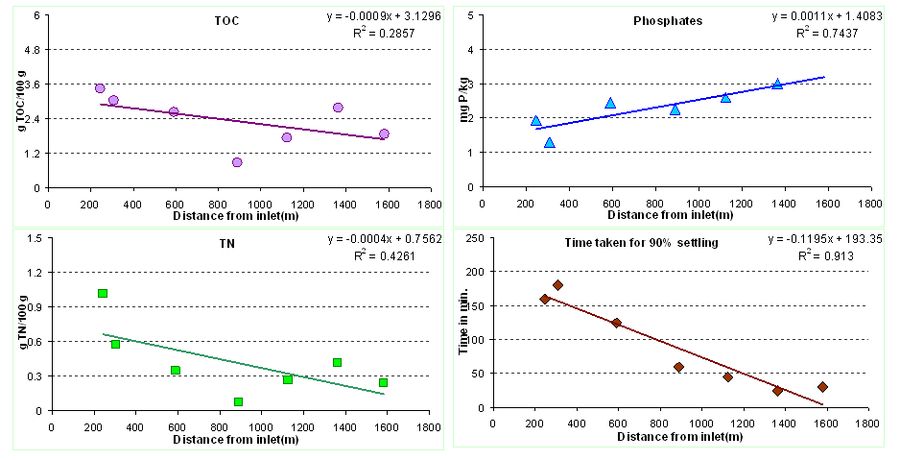1 Centre for Sustainable Technologies,
2 Centre for infrastructure, Sustainable Transportation and Urban Planning,
3 Energy and Wetlands Research Group, Centre for Ecological Sciences, Indian Institute of Science, Bangalore 560 012, India Results and discussion The volume of the Varthur lake is estimated to be 2.42 X 109 liters at an average water depth of the lake of 1.1 m with a water spread area of 220 ha. The retention time of sewage in this lake is about 4.84 days considering the influx of 5.00X108 l/d (500 MLD). Bellandur lake connects to Varthur lakes through wetlands with floating as well as rooted macrophytes (Figure 2) such as Typha augustifolia, Colocasia esculenta, Cyperus sp., Alternanthera philoxeroides, Eichhornia crassipes, Lemna gibba, Lemna minor (duckweed), Pistia stratiotes, etc. The water hyacinth is the primary colonizer of this zone followed by Alternanthera sp. Algae species were mostly dominated by Nitzschia sp., near inlet; Chlorella sp. and Cocconies sp. in the middle and euglenophytes, Lyngbya sp. and Oscillatoria sp. near outlet. Diurnal variations of DO were analyzed at outlets at north and southern sides influenced by the presence of macrophytes especially water hyacinth in the lake during January and April are given in Figure 3. The graph on the left shows DO measured at the south outlet when it is free of water hyacinth while the right side shows DO measured near macrophyte infested area. There was no improvement in the DO levels of the North outlet because of persistent stagnation and the presence of floating macrophytes. South outlet area had high DO in January where there was no water hyacinth cover. However, this became low in summer when water hyacinth covered this area. North outlet always covered by water hyacinth, showed low DO both in summer and monsoon periods. Froth formation observed in lake during the summer period was due to higher concentrations of detergents in summer flow.
The entry of partially treated sewage and direct inflow of raw sewage from the catchment to the inflow channel renders the inlet zone anaerobic, characterized by dark colour, heavy accumulation of organic sludge and as well as low DO. This anaerobic zone occupies a third of the distance from the inlet during rainy and winter months (July to January). From February to June, the spread of the macrophytes cover is also high and the anaerobic zone extends to over two thirds of the water spread area. The months of mid-June to December (monsoon period) is accompanied by gusty and high velocity winds that play a major role in the spread and dispersal of floating macrophytes across the waterspread area and high runoff pushing floating macrophytes towards the outlet and down the spillways. In the absence of floating macrophytes, following a short and dark anaerobic zone, water rapidly turns green to indicate the presence of microalgae and their possible role in treating water aerobically. Macrophyte cover greatly increases in summer covering almost 70-80% of the water spread area (Figure 2) and impedes the aerobic functions of the lake. Algal photosynthesis and consequently algal N-uptake and oxidation of BOD is checked by the coverage of macrophytes on the lake surface which completely changes the way the lake functions towards purifying the wastewater. During monsoon periods, strong winds churn and make the settled sludge to float and spill out of the outlets and paves way for sustainable functioning of the lake. The BOD values ranged from 44 mg/l(Nov)–186 mg/l(Mar). A considerable reduction in BOD upto 60% (from 100 mg/l to 40 mg/l, <20-30 mg/l in filtrate) was observed between the inlet and the outlets during August-January. Figure 4 illustrates the monthly variations in BOD at inlet and outlet. However the extensive coverage of macrophytes during February to May, lowered the organic decomposition which can be attributed to the very high concentration of inlet sewage; inadequate algal photosynthesis; enormous growth of water hyacinth covering almost the entire lake surface area and hence BOD removal was much lower during this period. This confirms that macrophytes impede the growth and functioning of algae. The lake bottom sludge collected from outlet to inlet roughly at an interval of 250m were analyzed for TOC, TN, phosphates and time taken for 90% settling. The results show that inlet portions are rich in organic matter indicating obligate anaerobic environment with TOC 3.5g/100g of sludge dry wt and TN value of 1g/100g sludge dry wt (Figure 5). However, the phosphates (Figure 5) showed much higher concentrations towards the outlets (3 mg/kg dry basis) compared to the inlets (1.3 mg/kg dry basis). The time required for 90% settling reveals improved and mature organic sludge found at the outlets (Figure 5).
From the data presented here we clearly see a potential for engineered and managed sewage fed water bodies to be used as effective wastewater treatment systems allowing for capture of plant nutrients and energy capture, recycle on land, provide various ecosystem services, generation of revenue, better water and food security (fish) making it a prospective alternative to conventional wastewater treatment systems in tier-2 cities of India. This not only ensures a pollution free environment but also makes the water safe to be reused in a myriad ways improving the overall water security in the future. Citation: Durga Madhab Mahapatra, Chanakya H. N and T. V. Ramachandra, 2010, Sustainability and treatment potentials of an urban sewage-fed lake in Bangalore, India. Proceedings of the 17th National Symposium on Advances in Environmental Monitoring and Modeling, May 13-15, 2010, IIT Kanpur, Uttar Pradesh.
|
||||||||||||||||




